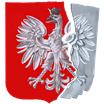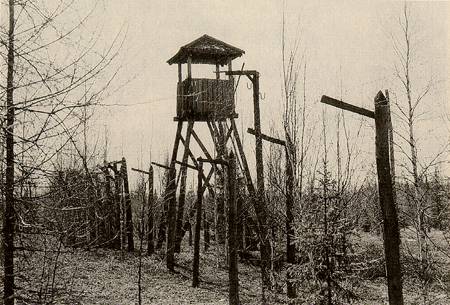Timeline of Events – 1945
World War II – Poland



Home Army (AK) - After the battle


Polish People's Army in Berlin

Gulag Tower
January 1 – Polish and Soviet forces take Warsaw.
January 15 – Gestapo shoots 79 Poles in Krakow as the
Red Army approaches.
January 17 – Red Army takes over Warsaw whose prewar population of 1,300,000 has been reduced to zero, and 90% of the city destroyed. At Mlawa, 320 Poles, mostly partisans, are shot by Germans in one of many last-minute executions around Warsaw.
January 18 – Nazis evacuate Auschwitz: 15,000 mostly Jews from Birkenau; 16,000 mostly Poles from Auschwitz Main Camp; 10,000 Jews, Poles and others from Monowitz; 16,000 Jews and others in factories of Auschwitz area. Many will be killed on the trek into Germany.
January 27 – Auschwitz is liberated by Red Army. Those murdered in Auschwitz were 960,000 Jews, 275,000 Poles, 25,000 Gypsies and 15,000 Soviet POW’s.
February – Winston Churchill tells the House of Commons: “His Majesty’s Government will never forget the debt they owe to the Polish troops who have served them so valiantly. I earnestly hope that it is possible to offer them citizenship and freedom of the British Empire.”
February – March – About 20,000 Polish miners are deported by Soviets from Katowice to Kazakhstan.
February 2 – 3 – A group of 1,000 Ukrainian Bandera supporters attack village of Czerwonogrod, shooting or burning to death 38 people including members of the Polish self-defence group.
February 4 – 11 – Yalta Conference. Stalin’s demands for control of Poland and Eastern Europe meet little opposition from Churchill and FDR.
March 24 – FDR forbids staff to say anything about Soviet guilt for Katyn.
March 28 – Top Polish political leaders go under safe conduct for discussion with Soviet officials near Warsaw. They are arrested and taken to Moscow where they are charged with “crimes against the USSR” despite protest from Allies.
April – Soviets hold 8,000 Polish prisoners in the Royal Castle in Lublin. The Soviets declare the death penalty for membership in the AK, for possession of weapons, and for aiding partisans.
April 12 – 1st Polish Armoured Division liberates 1,728 female AK members from Oberlangen Stalag.
April 21 – Polish 2nd Corps liberates Bologna.
April 30 – Hitler commits suicide in Berlin after learning the German army group “Mite” ordered by him to rescue Berlin had been defeated by the 2nd Polish Army. Killed were 26,000 German elite troops while 27,000 were taken prisoner.
May – June – Operation Keelhaul sees forced repatriation of 50,000 Cossacks from Austria to USSR by the British and Americans, even though they know this means death or captivity. Some Allied officers refuse to carry out orders as many Cossacks choose suicide over Soviet captivity.
May 6 – 1st Polish Armoured Division hoists flag over Wilhelmshaven, main German U-boat base.
May 7 – Unconditional surrender by all German forces.
May 8 – VE-Day (Victory in Europe).
May 21 – AK frees 1,400 Polish prisoners from NKVD prison in Rembertow.
June 5 – Allies divide Germany into occupation zones.
July – The NKVD and Red Army round up anti-communist Poles in the Suwalki area: 1,300 people disappear and are presumed killed.
July 5 – Britain and USA announce they no longer recognize Polish Government-in-Exile in London. Polish soldiers and civilians in the British Commonwealth and elsewhere are pressured to return to a Poland under Soviet control. Most refuse.
July 17 – August 2 – Potsdam Conference. Allies recognize a line along the Oder and Neisse Rivers as the border between Poland and Germany.
August 6 – USA drops atomic bomb on Hiroshima.
August 15 – VJ-Day (Victory in Japan).
August 16 – USSR and Poland agree on Curzon Line. Poland’s borders are shifted west as she loses 70,000 sq. miles to the USSR and gains 40,000 sq.miles from Germany. Massive population displacements follow as 3.5 million Germans are removed and their homes taken over by 2.2 million Poles returning from German concentration camps and slave labour, and 1.5 million Poles ousted from areas taken by the USSR.
November 20 – Nuremberg War Crimes Tribunal opens. Stalin sends Andrei Vyshinsky (chief prosecutor who executed hundreds of thousands in 1930’s) to keep Soviet crimes out, including Katyn. Vyshinsky succeeds.
1945-1953 – Some 5.5 million Soviet citizens will be returned by the Western Allies to USSR. These are POWs, slave-labourers, exiles, soldier who fought for Germany and even those who never were Soviet citizens. About a million will be executed or sentenced to 25 years in the Gulag.
Christopher Jacek Gladun was born in 1951 and grew up in Canada to where his family emigrated from England as displaced persons. Sadly, Chris died in Toronto in March 2003. He held a diploma in Journalism from the Niagara College and a BA in Polish Language & Literature from the University of Toronto. Chris also acted as interviewer and researcher for the documentary film “Rescued From Death in Siberia”.
This content is now maintained by the Kresy-Siberia Group, which Chris was a charter member of and which is taking his website and his research work forward.